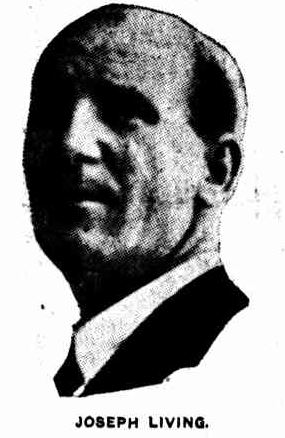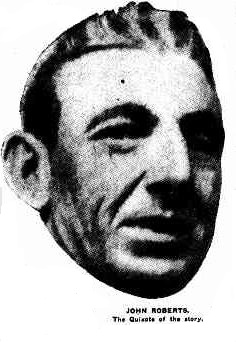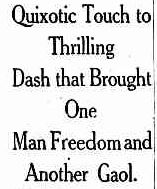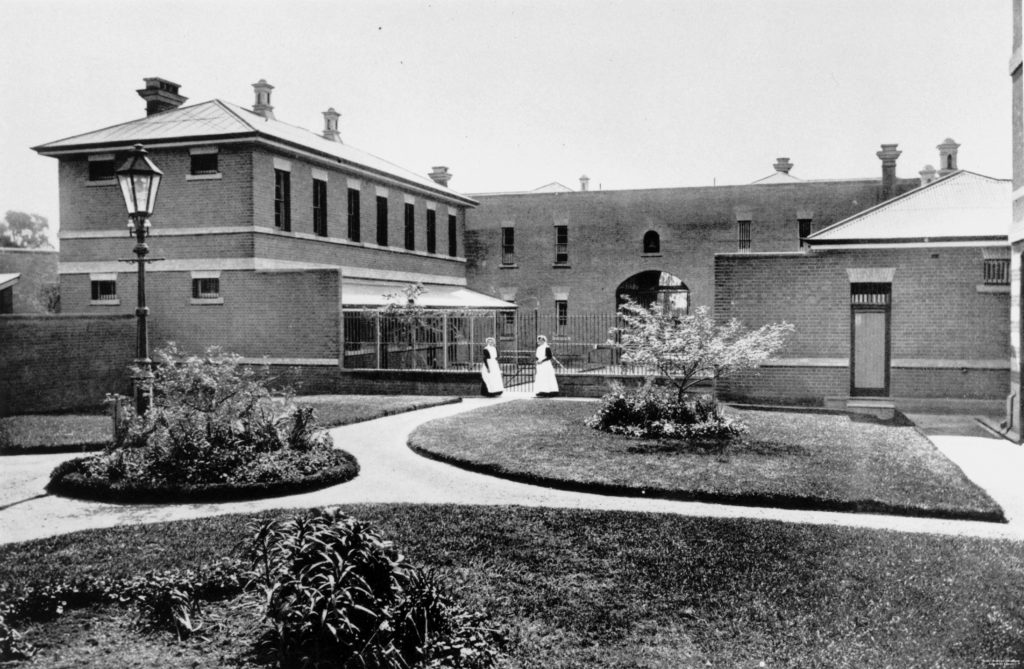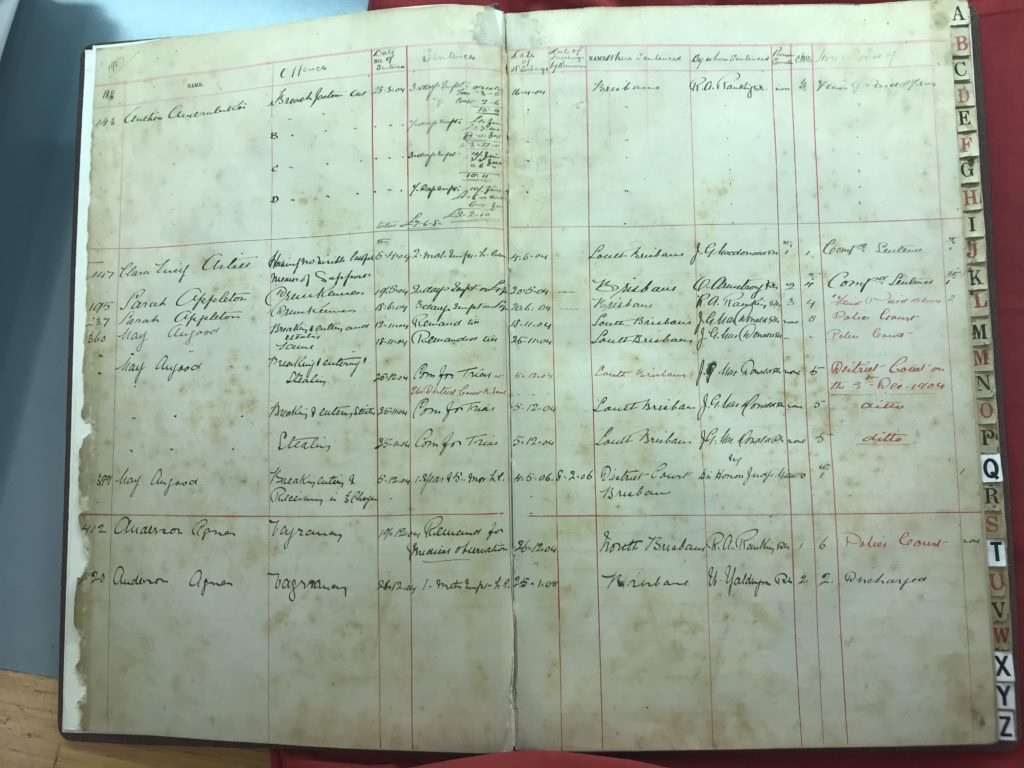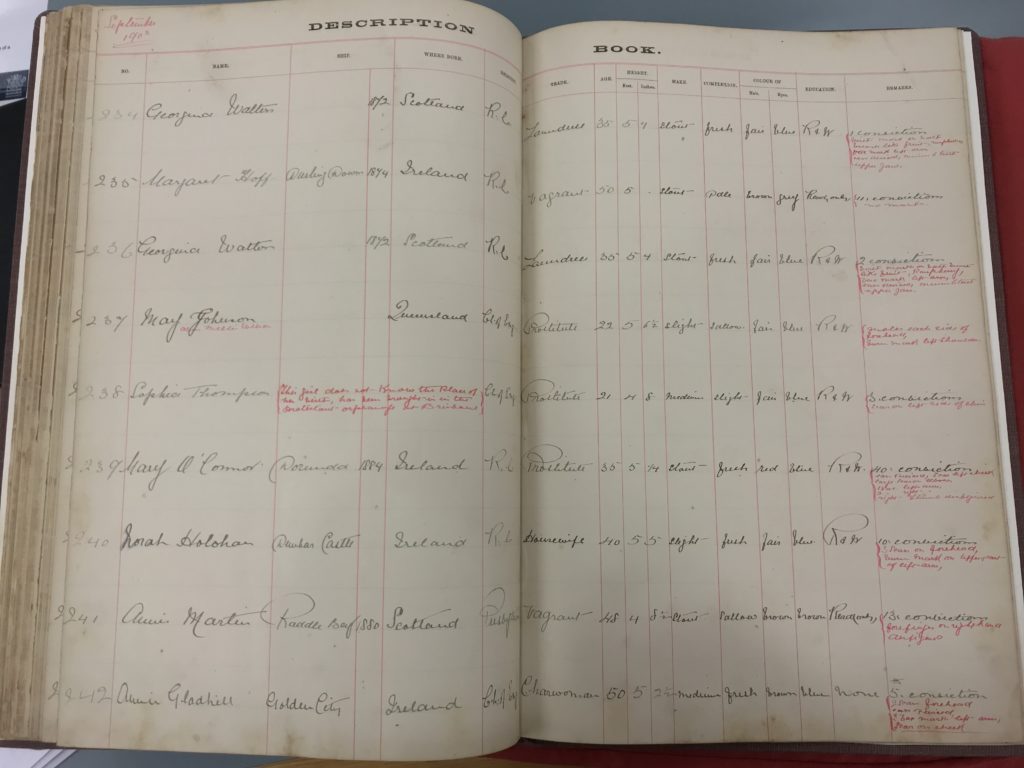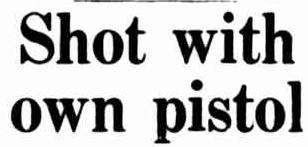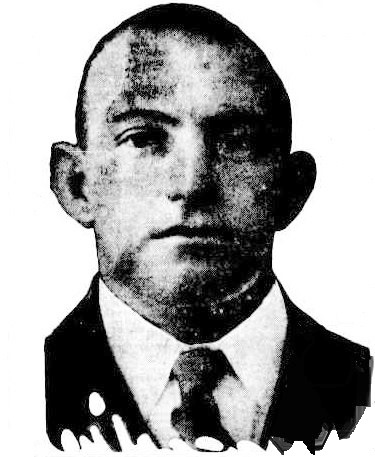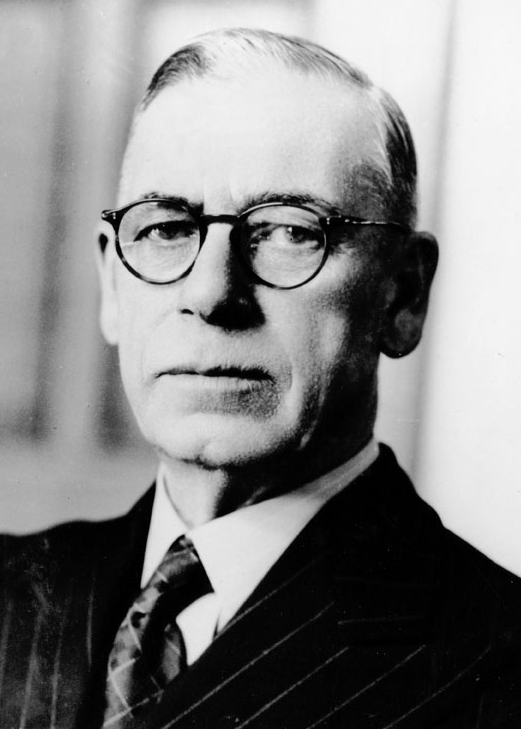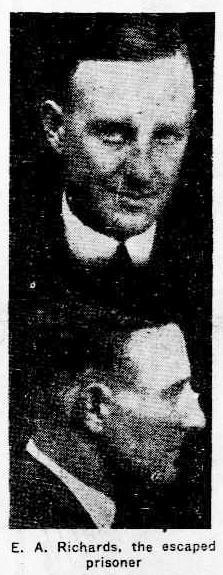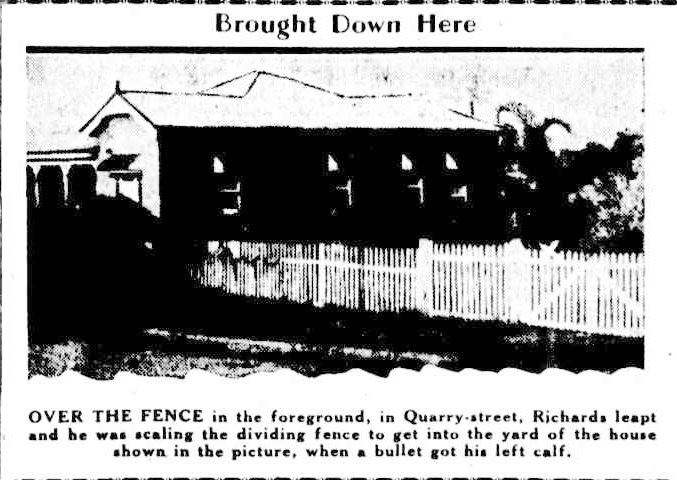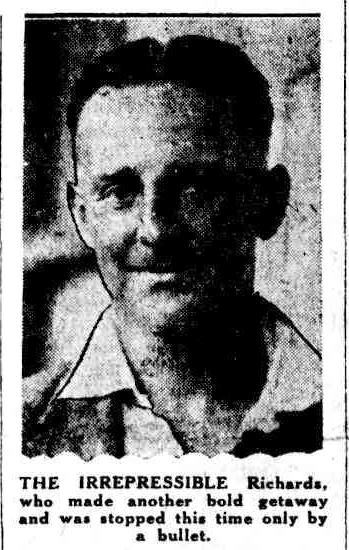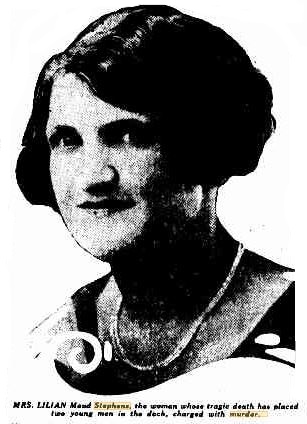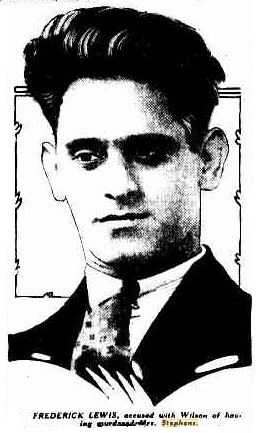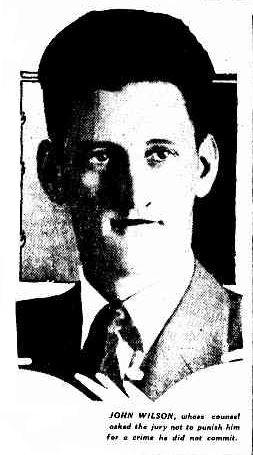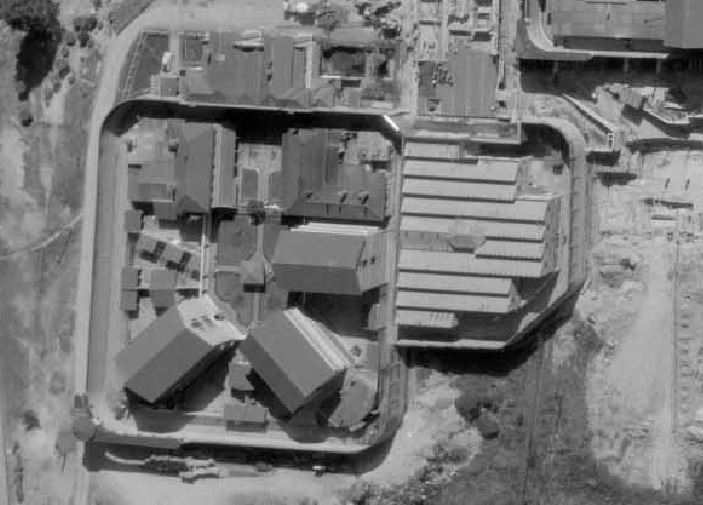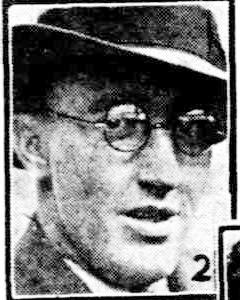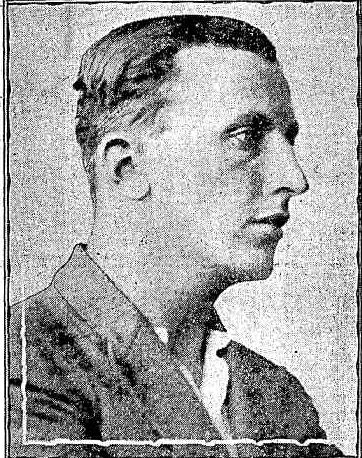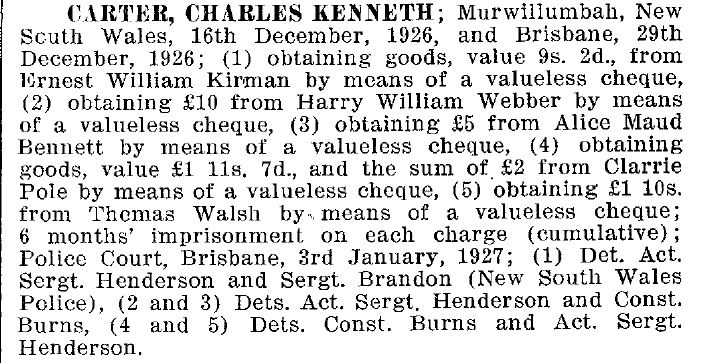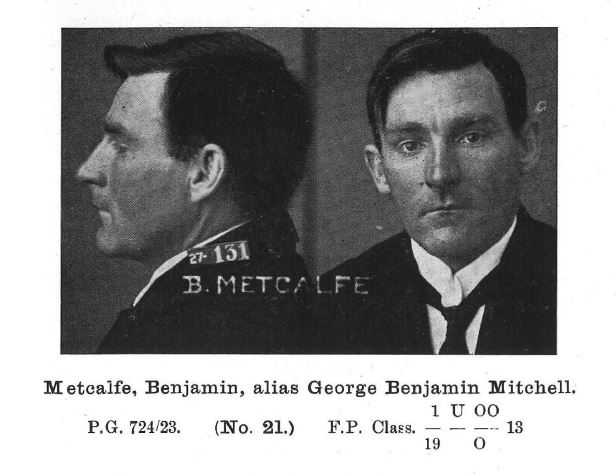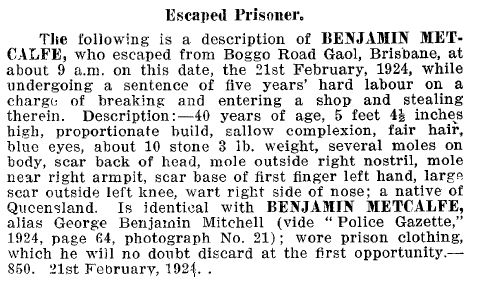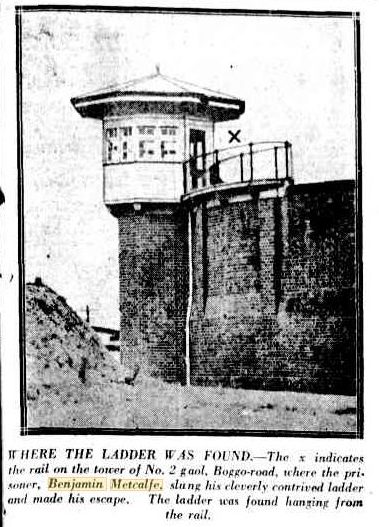Escape! – Percy Lee
- On : 9 June, 2018
- By : Boggo Road Gaol
- Category : Stories
- View : 1798
Escape! Percy Lee
Percy was a ‘dip artist’ (pickpocket) and a good one. Percy served numerous short sentences in gaols’ all over New South Wales; all for theft in one way or another. Escaping the heat from his crime, Percy ventured over the border into Queensland.
Escape! Percy Lee
Description:
Age: 28
Height: 5ft 10 inches
Weight: 12stone 8lb
Hair: Dark Brown
Eyes: Brown
Complexion: Sallow
Build: Proportionate
Marks: Four vaccination marks on Left forearm.
Cut right side of forehead. Scar left forehead, scar on each knee.
Occupation: Tailor
Native Place: New South Wales
Aliases: James Lee, Percy John Lee.
Percy Lee was born into a large family living in Merriwa, New South Wales. His father, a farmer, and his mother, who worked home duties, raised him in a good catholic family. Percy was well educated and worked the family farm from a young age and later as a jockey riding in the local race meetings. In 1914 war broke out and the losses were heavy. As war entered its second year, reinforcements were called for. Percy lied about his age so that he could enlist. He was only sixteen when he was sent to France. Twice wounded in action, he returned home at the end of 1918.
Back home, the great depression had hit. There were no jobs, especially for young men with war wounds that were unable to work doing physical labour. This was when Percy first had his run in with the law.
Percy was a ‘dip artist’ (pickpocket) and a good one. Percy served numerous short sentences in gaols’ all over New South Wales all for theft in one way or another. Escaping the heat from his crime, Percy ventured over the border into Queensland.
It wasn’t long until the arm of the law reached Percy. Percy Lee was charged on the 8th of May 1926 with two counts of stealing. The police magistrate sentenced him to six months for each charge to be served cumulatively. Off in the black maria to her majesty’s prison (Boggo Road Gaol) he went. Just two short weeks later, he would meet John James Roberts, also in for stealing. Roberts was in for six months, however, he could reduce his sentence by paying a fine if he could get the money together. In the meantime, Percy and Roberts put their heads down and were of best behaviour. They became good pals. Thick as thieves, so they say.
Their friendship didn’t long get started when Roberts was released on the 19th of June; he had raised the funds to pay the fine. To Percy, all was lost. His mate was gone, but he knew what he had to do. He had to keep his head down and be on his best behaviour. He had to get out of there.
The Escape
At 10:40 am on Monday the 16th of August, 1926 Percy was engaged in repairing a fence outside of the gaol walls under the supervision of an armed warder. Just then, a speeding dark yellow motor car was driven up and swerved around as Lee sprang to his feet and onto the footboard and slid into the car. The car sped away in the direction of the city carrying its four occupants. The warder, realising what has happened fired his revolver, the bullets struck the car twice, but without much effect. Percy had escaped. The alarm was sounded, and the area was quickly swarming with police and warders from the prison.
The next afternoon, a pair of prison trousers, a black vest and leather braces that the prisoner was wearing at the time of his escape, were found in Grey street, South Brisbane.
Over the coming months, it would become clear that Percy was gone. He certainly wasn’t in Queensland and the authorities have not found trace of him in his home state of New South Wales. Where had he gone?
The Investigation
The investigations were continuing in Brisbane; how had he got a message out from inside the prison? How had he set up the escape at that exact time? The police put out a request for information. Weighing heavily on his mind, a taxi driver of Russian heritage named Alexander Douglas stepped forward. He admitted that he was the driver of the car that aided the escape of Percy Lee.
Detectives badgered Douglas for hours; he explained that he was threatened into driving the car by another man, John Roberts. He explained how Roberts wound cloth over the number plate of his cab so it wasn’t seen. Roberts had arranged everything, even clothing for Percy to change into.
A patrol car was sent to collect John James Roberts. He was charged with having aided and abetted Percy Lee, however, not before he had named the fourth man in the vehicle, Joseph William Living, a friend of his. A wharf labourer residing at New Farm, Living was sent for. However, he denied he knew anything at all about the plan. The first he knew of it was at the moment it was happening.
Living protested his innocence. Finally, Roberts confessed that he had cooked up the plan with Percy Lee while he was inside Boggo Road. He had received a message over the weekend that the work on the fence would be completed soon… and Monday was the day.
Just how that message got out of the Gaol is a matter that is lost with time. Roberts and Living were charged with having aided and abetted Percy Lee. Roberts pled guilty, adding the statement that Living had nothing whatsoever to do with the escape, he had just been in the car at the time. Living was released. Roberts gained another year in Boggo Road.
Capture
Seven long months later, in March 1927, a police officer in New Zealand spied a man that looked familiar. It was the escaped prisoner from Australia, Percy Lee.
Percy was returned to Australia. Though not to Brisbane; Percy had an outstanding warrant for his arrest in Sydney on the charge of serious assault and robbery. Percy was to be lodged in Long Bay Gaol for the next twenty three months, with the Queensland authorities waiting to bring him back to finish his seven months in Boggo Road. He never did return to Queensland. Instead, he married and spent the rest of his life with a sickly, emotionally tormented wife and no work. He loved her, but she needed help that he could not afford to give her. Consequently, Percy was in and out of prison. His wife died tragically young. Percy was in and out of prison into the forties, before finally disappearing from the records forever.
Want to see where Percy Lee escaped? You can! Join us for our Escapes tour this Sunday! Hosted by Director Jack Sim, you will hear of some of the greatest escape stories from the history of Boggo Road Gaol. To book click here
This article was contributed by Research Coordinator Sue Olsen as part of the ongoing research program for Boggo Road Gaol Pty Ltd. The aim of the program is to bring to light and share articles relating to Boggo Road for the purposes of review and study. Do you have a story to share or something you would like us to know about? You can contact the research team here
From the Archives – HM Prison for Females
- On : 1 June, 2018
- By : Boggo Road Gaol
- Category : Stories
- View : 2369
From the Archives – HM Prison for Females
His Majesty’s Prison for females (later known as number 2 division Boggo Road Gaol) operated from 1903 to 1921 before being moved to other buildings on the gaol reserve. Each month the prison players bring to life the female division of Boggo Road Gaol.
This Sunday why not escape the 21st century and experience it for yourself?
From the Archives – HM Prison for Females
His Majesty’s Prison for females (later known as number 2 division Boggo Road Gaol) operated from 1903 to 1921 before being moved to other buildings on the gaol reserve. Each month the prison players bring to life the female division of Boggo Road Gaol.
Coinciding with the Prison Players performance this Sunday we would like to make mention of a series of records that has become invaluable to adding colour to the performances.
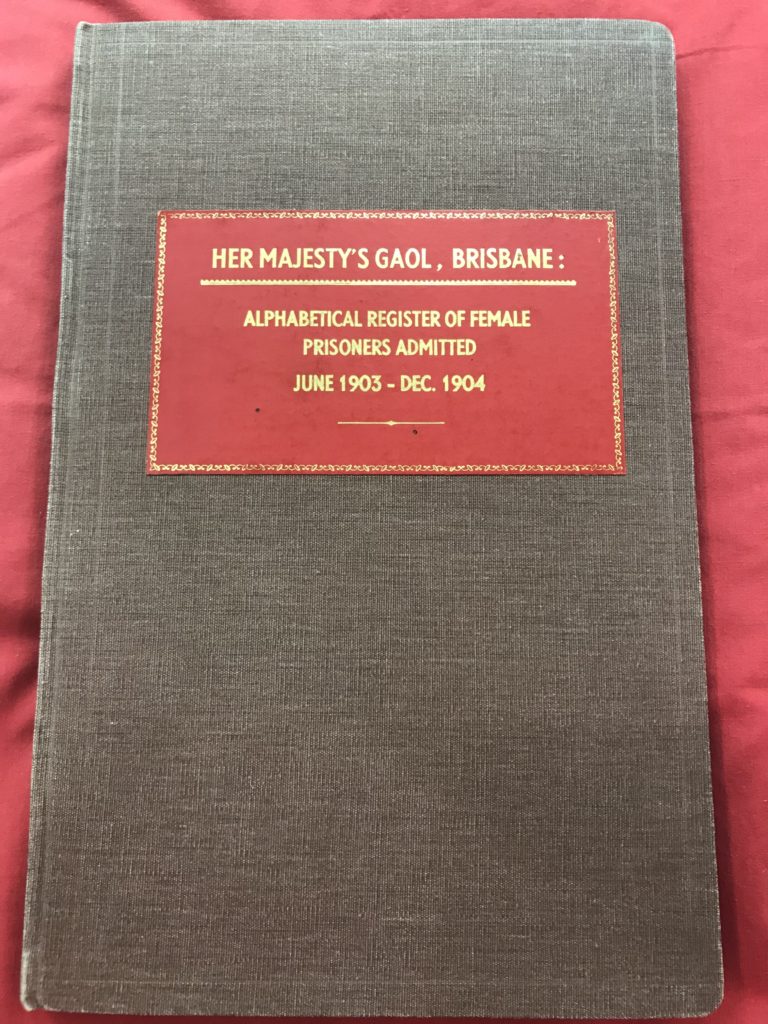
Sadly these records are far from a complete series; however they do cover the initial period where the women were housed in what we now know as number two division Boggo Road Gaol, the only remaining portion of the gaol.
The admission register lists the basics on the prisoner for each admission that they make to the prison. This record is arranged by alphabetical order by surname and then in numerical order by year (for example: 243 /1903 Smith, Agnes) this record goes on to record the sentencing information, the location of their trial, the magistrate that heard the case, and even how the prisoner was disposed of. (For example: how much of their sentence did they serve and their release date)
The description book lists the basic information about each prisoner, such as their full name, place of birth, any aliases that they may be using. Physical information such as their weight, height, eye colour, skin tone and build are also recorded. In some records their level of education and occupation is recorded as well as any prior convictions that the prisoner may have.
As you can see, for the researcher these records give a picture of the prisoner at a time where photographs were not taken. Therefore they become an essential part of the story of Boggo Road Gaol.
The research team hopes that this gives the reader an idea of the types of records that are available for specific research on a particular prisoner in Boggo Road Gaol.
So when you get the opportunity to see the prison players in action, you can understand the level of research that goes into providing the most immersing and accurate portrayal possible.
This Sunday, why not escape the 21st century; leave behind the cars, air conditioning, electricity and modern technology. Bring along the family and show them what life was like before all of the modern conveniences and even some of the things we see as basics to everyday. Click here to secure your tickets.
This article was contributed by Research Coordinator Sue Olsen as part of the ongoing research program for Boggo Road Gaol Pty Ltd. The aim of the program is to bring to light and share articles relating to Boggo Road for the purposes of review and study. Do you have a story to share or something you would like us to know about? You can contact the research team here.
From the headlines: Officer Frank Johnstone
- On : 25 May, 2018
- By : Boggo Road Gaol
- Category : Stories
- View : 1607
From the headlines: Officer Frank Johnstone:
A short story this week; again from the headlines of the Courier Mail newspaper: The remarkable story of the officer who accidentally shot himself with his own pistol!
From the Headlines: Officer Frank Johnstone
The morning started out like any other for Frank; he rose early and dressed for work, eating his breakfast and collecting his lunch and flask of hot coffee from the kitchen table. Hurriedly he kissed his wife on the cheek as he left the door of their Bardon home. Little did he know how his morning would unfold!
The cold winter’s morning had taken its toll on Frank, even before he had arrived at work. He had put on an extra layer of clothing before the ride on the tram to Annerley and the short walk to the gaol.

The bullet flew from the chamber passing through Frank’s right leg, only narrowly missing his fellow officers before lodging in the wall of the armoury.
Frank fell to the floor wounded, the noise from the discharge of the pistol rang out over the prison and all haste was taken in discovering its source.
Frank was seen to at the prison hospital, his wound not being serious he was allowed to go home to recuperate.
A subsequent investigation ruled that the incident was an accident and no disciplinary action was taken against officer Johnstone.
The armoury and likely the bullet remain to this day, inside the gates of number 2 division Boggo Road Gaol. You can see the armoury on any of the tours of Boggo Road Gaol.
Want to know what it was like to be an officer at Boggo Road Gaol? Want to know how easily an accident like this could happen on a cold winter’s morning? Come along this Sunday for our officer tour and meet former officer Kevin Hayden! For more information click here
This article was contributed by Research Coordinator Sue Olsen as part of the ongoing research program for Boggo Road Gaol Pty Ltd. The aim of the program is to bring to light and share articles relating to Boggo Road for the purposes of review and study. Do you have a story to share or something you would like us to know about? You can contact the research team here.
From the Headlines…From Boggo Road to Marry
- On : 18 May, 2018
- By : Boggo Road Gaol
- Category : Stories
- View : 1563
From the Headlines …From Boggo Road to Marry
“From Boggo Road to Marry & Back to 10 Year Sentence” A story from the Headlines of the Truth Newspaper on the 10thof December 1939, tells the remarkable story of prisoner John Daniel Robertson who was given the extraordinary permission to marry while under sentence of ten years at HM Prison Men Brisbane (later known as Boggo Road Gaol)
“From Boggo Road to Marry & Back to 10 Year Sentence” A story from the headlines of the Truth newspaper on the 10thof December 1939, tells the remarkable story of prisoner John Daniel Robertson who was given extraordinary permission to marry while under sentence of ten years at HM Prison Men Brisbane (later known as Boggo Road Gaol)
The Crime
John Daniel Robertson was found guilty of the rape and indecent assault with violence of a young woman in Mackay in August of 1938. He had followed her from her work and dragged her into a laneway and viciously assaulted her.
The victim was able to make an escape and found a nearby policeman; he followed her to the scene and arrested Robertson. A short time later she formally identified him in an interview. Robertson was held for trial before the police magistrate.
The Sentence
In the March 1939 trial, Robertson and his team failed to impress upon the jury and Mr. Justice Douglas of his innocence of the four charges against him. He was found guilty and sentenced to Fourteen years imprisonment with hard labour.
The Appeal
Almost as soon as the cell door had slammed shut on Robertson, His friends and workmates had begun to rally behind him raising the funds for him to be able to appeal his case. He wished to have a new trial, this was denied. However with the review of the case his sentence was changed to ten years with hard labour.
Permission to Marry
In days gone by, it was traditional to ask the bride’s father for permission to marry… In this case permission to marry had to be sought from the minister for home affairs Mr. E.M. Hanlon. It was very uncommon for a long term prisoner to seek permission to marry simply because they were held behind bars for a long period of time. The case was given very close inspection by the minister before giving his permission. The location of the wedding was also a problem. It was out of the question for the wedding to be held inside the gaol. So an alternative location had to be sought.
The Wedding
Romance descended on Boggo Road Gaol that Saturday October afternoon. A prison officer in his civilian clothing entered one of the cells and escorted Robertson to the superintendent’s office. A word of congratulations and wishes for good luck from the Superintendent and Robertson (still under control of the officer) left the gaol precincts for the Holy Trinity Church at Woolloongabba. The wedding was held with great secrecy so as to prevent the public finding out, with the risk that it would turn into some sort of circus with a large number of curious spectators flocking to the site. Under this veil of secrecy only the immediate family of the couple was permitted to attend. A few short minutes after the service was completed Robertson was bundled off back to his cell in Boggo Road with his bride left to entertain the family.
The Aftermath
Robertson no sooner had married that he had sent a request to the parole board for release. He wished to be released into his wife’s custody, with other requirements to be met under the parole agreement.
At the date of this article no decision had been made on his parole.
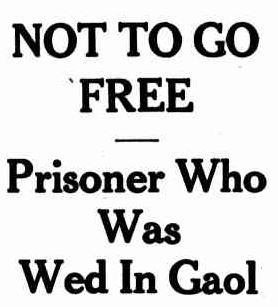
NOT TO GO FREE was the headline. And is perhaps all the reader needs to know.
The article goes on to state:
Robertson is at liberty to lodge a further petition at a further date but the board will not consider his release until he has served a longer portion of his ten year sentence.
Robertson was very certain he would secure his parole. He considered that he had been granted permission to marry; his freedom then on parole should be almost automatic. Reports to the truth from inside the gaol show that Robertson was a very disappointed man when the decision was communicated to him.
So it was, Robertson was locked up in Boggo Road Gaol serving his ten years… waiting for his opportunity to apply for parole again.
This story has so much more to tell… so many unusual twists and turns to be revealed… Perhaps the most unusual that was yet to be revealed to the public we will tell you right now.
The woman he married with such extraordinary secrecy was the same woman that put him in gaol in the first place.
His victim.
This Sunday, you can hear more stories from a prisoner’s perspective. Larry Campbell, a former prisoner at Boggo Road, will guide you through some of the most turbulent years of the Gaol’s history. To book tickets for our fascinating prisoner tour click here.
Did you know that unlike John Daniel Robertson… you can have your wedding in gaol? For more information visit here
This article was contributed by Research Coordinator Sue Olsen as part of the ongoing research program for Boggo Road Gaol Pty Ltd. The aim of the program is to bring to light and share articles relating to Boggo Road for the purposes of review and study. Do you have a story to share or something you would like us to know about? You can contact the research team here
Escape! Ernest Albert Richards
- On : 11 May, 2018
- By : Boggo Road Gaol
- Category : Stories
- View : 1925
Escape! – Ernest Albert Richards
New Years Eve 1931, Notorious habitual criminal Ernest Albert Richards, serving a ten year sentence in Yatala Prison, South Australia walked out of the prison somewhere between midnight and six am. Richards was unknown in Queensland. But he was soon known to Brisbane, more specifically the notorious Boggo Road Gaol.
Escape! Ernest Albert Richards
Notorious habitual criminal, Ernest Albert Richards was very well known in South Australia. Born there in 1903, he was in trouble from a young age; being a ward of the state and not ever wanting to do as he was told. His crimes range from petty theft to robbery with violence. He was unknown to the residents of Brisbane even after committing a sensational violent robbery of a Post Office in Adelaide, South Australia in 1930. For which, Richards gained himself a ten year sentence with hard labour in Yatala Prison. Indeed, it wasn’t until 1932 that anyone in Brisbane knew of Ernest Albert Richards. You see, Ernest had no desire to remain in his solitary accommodations for a new year.
Around midnight on New Year’s Eve 1931, after making the appropriate arrangements, Ernest escaped from his cell, one of the strongest in the prison. His cell was in an island of four cells in the main yard of the prison; used especially for the isolation of troublesome inmates.
The cells were surrounded by a caged yard twenty feet by ten feet in size. Richards was sentenced to four months in this solitary confinement, even doing his work in either his cell or in the attached yard.
Somehow, Richards gained a key and unlocked the four locks on the two outer doors of his cell, climbed up and bent the bars of the top of the caged yard open and using a rope made from his coir mat bedding scaled the outer wall of the prison and vanished into hush of the early morning.
Ernest Albert Richards
Occupation prior to arrest: Electrician and Mechanic.
Known alias : Woolfington and Wilson
Height: Five feet six inches
Build: Medium
Complexion: Fair
Eyes: Blue
Hair: Light Brown
Remarks: Pointed nose and scar on right thumb.
Last seen wearing: White Moleskin trousers, Galatea Shirt and Rope Soled Slippers
Arrest in Brisbane
After weeks of searching in the southern states, word had reached Brisbane that the notorious Ernest Albert Richards could be on his way. Indeed, He was already here. Richards had arrived a day or two prior. At 8pm on the 16th of February in Ann Street Brisbane, A man fitting Richards description was arrested by plain clothes police officers for vagrancy. He was taken back to Roma Street Station and questioned. He immediately admitted his identity and was placed in a cell to appear before the police magistrate the next morning.
Next day in court, the vagrancy charge was dropped and Richards was remanded in custody for seven days in order for the original arrest warrant to arrive from South Australia.
During the surrounding media circus, Richards sold his remarkable escape story to the Truth newspaper. You can read the full story here
To His Majesty’s Prison Brisbane
Richards was sent off to serve his seven days remand in His Majesty’s Prison Brisbane (Later known as Boggo Road Gaol) Surely, the notorious Boggo Road could hold Ernest.
Well, four days later while exercising in the yard, Richards climbed a wooden fence and secured a piece of gas piping that ran along the yard near the wall. He hooked one end over the wall and clambered up it. He was immediately seen by a warder on the watch tower.
Drawing his revolver the warder fired a fusillade of shots, some bullets grazing Richards. Though he managed to make it over the wall and dropped down to the grass outside. He darted on the roadway that runs beside the prison.
Escape!
Richards was seen by Acting Superintendent Whitney from his balcony, who immediately alerted warders in the gatehouse who dashed out the front gates armed with rifles and revolvers firing shots and shouting for Richards to stop.
Richards scrambling down the railway cutting, fell, but quickly recovered; the warders’ followed. One falling heavily, but he recovered enough and fired his rifle. Richards meanwhile was climbing a fence opposite near the Park Road station. The round struck Richards in the left calf. He was wounded, but still managed to make it over a two more fences in Quarry Street.
The wound was slowing him down, it was bleeding badly, and the warders were gaining on him. Richards found his way through some thick bushes into Rev. Atkins back yard and crashing through the netting into the chook run, he hid in a small shed out of sight.
Richards thought if he lay low, this would be a good place to hide. The warders would surely pass him by; but presently a rifle was thrust into his face and he was ordered to come out. Richards was carried by stretcher to an awaiting motor car that swiftly returned him to prison with just nine short minutes of liberty.
 Return to South Australia
Return to South Australia
Three days later, Richards further appeared in the police court Brisbane; the magistrate ruled “ I order that you be returned to Adelaide”. The warrant and his escort had arrived, Richards departed on the Kyogle Train on Friday the 26th of February 1932. On arrival in Adelaide, Richards appeared before the court on charges of escape. He received an additional eighteen months on his original ten year sentence.
Want to see where Richards went over the wall? You can! Join us for our Escapes tour this Sunday! Hosted by Director Jack Sim, you will hear of some of the greatest escape stories from the history of Boggo Road Gaol. To book click here
This article was contributed by Research Coordinator Sue Olsen as part of the ongoing research program for Boggo Road Gaol Pty Ltd. The aim of the program is to bring to light and share articles relating to Boggo Road for the purposes of review and study. Do you have a story to share or something you would like us to know about? You can contact the research team here
Lifers – Frederick Emanuel Lewis and John Wilson
- On : 5 May, 2018
- By : Boggo Road Gaol
- Category : Stories
- View : 2532
Lifers – Frederick Emanuel Lewis and John Wilson.
Shot her down in cold blood!
The most brutal and cold blooded hold up in Brisbane in many years took place at Pope Street off Gladstone Road at Dutton Park at the home of Mr. and Mrs. Richard Stephens from the Paddington Picture Theatre.
Shot her down in cold blood!
The most brutal and cold blooded hold up in Brisbane in many years took place at Pope Street off Gladstone Road at Dutton Park at the home of Mr. and Mrs. Richard Stephens from the Paddington Picture Theatre.
It was 11:30pm on the 30th of January 1932, the Stephens family returned home from the theatre with the evening’s takings. As the family car pulled into the drive way and into the garage they were startled by a loud report. Mr. Stephens thought it was a blow out. Laughingly he said ‘we were lucky to make it home!’
While inspecting the tyres he heard a second report and was met with the shouts of “Stick Em Up! Quickly!” and a revolver pointed at him. He laughed it off and said “Go on, that’s only a pop gun! Clear out or I will get my own revolver to work! the bandit replied… come on Dick… just hand it over! Clearly the bandits knew the Stephens.
A struggle broke out between the two bandits and Mr. Stephens and his fourteen year old son Vernon. Vernon was holding the bag containing the £75 takings; he was felled by a hit on the head with the revolver. Mr. and Mrs. Stephens grappled with both men, Mrs. Stephens swung one aside and screamed for help, As she did the bandit pressed the revolver against her chest and fired. She fell to the ground in a pool of blood.
The bandits fled on foot towards Gladstone Road. Mr. Stephens and Vernon gave chase. The bandits firing at least eight shots at their pursuers, they reached a waiting motor car and escaped firing off a few more shots as they fled.
Not knowing his wife had been fatally wounded, Mr. Stephens attempted to revive her with Brandy. Unfortunately Mrs. Stephens had received a shot to the heart and nothing could be done. Sadly, their youngest son George, seven, was sleeping inside the house and hadn’t heard a thing.
Mrs. Stephens was laid to rest in the Toowong Cemetery.
 Frederick Emanuel Lewis
Frederick Emanuel Lewis
Twenty Five year old Frederick Emanuel Lewis was convicted of the murder of Mrs. Lillian Stephens. He was the eldest son of Frederick and Elizabeth Lewis. Frederick Lewis senior was of Indian descent. He had a prosperous fish and chip shop on Given Terrace at Paddington just a few doors from the Paddington Picture Theatre and next door to the Paddington Hotel (The Paddo Tavern). In the trial he admitted that he was the one that shot Mrs. Lewis, and also admitted to the location of the money. Asking his brother to go and collect it and turn it into the police. Francis, his brother refused to do so and said that he should tell the police himself and they would send someone to collect it. He did.
Death
Frederick Lewis died in the gaol hospital on the 17th of May 1944 of Heart Failure.
Arthur Jones, Senior Warder said that he heard Lewis knocking and went to his cell. Lewis complained of pains in his chest and under his arms and asked for an indigestion mixture. Lewis was already receiving medication for heart troubles and was immediately taken to the prison hospital. Lewis had collapsed three weeks previously from similar trouble. Frederick Lewis was buried on the 19th of May 1944 by K.M Smith funeral directors in the family plot at the Toowong Cemetery.
Inquiry
A few months later, a coronial inquiry was held into the death of Frederick Lewis in front of Coroner J.J. Leahy. His brother Francis was in attendance and gave evidence that he had regularly visited his brother and that he was of good health. After the evidence relating to his death was heard and the certificate of death presented. The finding of the inquiry was that his death was from natural causes. The inquiry was subsequently closed and a report listed in the Courier Mail newspaper on the 14th of July 1944.
 John Wilson (known as Jack)
John Wilson (known as Jack)
The younger of the two, a twenty year old labourer; was the only son of George and Kathleen Wilson. John worked at the Newsagents just down the street from the Paddington Picture theatre. John was equally charged with the murder of Mrs. Lillian Stephens, and sentenced to life imprisonment. He was to serve fifteen years of a life sentence. He was released under remission for good behaviour under a scheme for long termers release after the end of World War Two.
John Wilson was not the person that shot Mrs. Stephens however he set out with Frederick Emanuel Lewis to rob Mr. and Mrs. Stephens of their hard earned takings at the Paddington Picture Theatre. He states for the Truth newspaper that he only received five pounds of the loot… in fact he had just shy of ten pounds on him when he was arrested. Allegedly, he won the money gambling. The remainder of the money was hidden… but as we know the location of that was quickly given up by his co-defendant.
When release, John Wilson turned to the trade that he had learned in Gaol; Tailoring. He returned to live with his aged mother at Stones Corner.
This Sunday, you can hear more stories from a prisoner’s perspective. Wayne Weaver, a former prisoner at Boggo Road, will guide you through some of the most turbulent years of the Gaol’s history. To book tickets for our fascinating prisoner tour click here.
This article was contributed by Research Coordinator Sue Olsen as part of the ongoing research program for Boggo Road Gaol Pty Ltd. The aim of the program is to bring to light and share articles relating to Boggo Road for the purposes of review and study. Do you have a story to share or something you would like us to know about? You can contact the research team here
From the headlines…War work inside Boggo Road
- On : 26 April, 2018
- By : Boggo Road Gaol
- Category : Stories
- View : 2325
From the headlines…. War Work Inside Boggo Road.
This week we commemorate ANZAC Day; the solemn reminder of all those good soldiers that have served for the freedoms that we enjoy today. It is also a time to remember those that are still serving in places over the globe. The prisoners of HM Prisons Brisbane (later known as Boggo Road Gaol) did their bit for the war effort. ANZAC Day was commemorated in Gaol just as it is in the freedom of society. Perhaps the most unknown fact is the war work which was undertaken by prisoners in Boggo Road.
From the headlines of the Truth Newspaper we share that five of the worst murderers in Queensland were engaged in war work. The article tells in remarkable detail the work that they are undertaking and a little detail about their individual crimes.
Prisoners of Boggo Road Gaol are on the warpath! They’re in an all-in battle to lick Hitler and his offsider, the scrawny little Tojo. The toughest of them – like mail train killer Herbert Kopit, hammer slayer Percy Airs, Cunnamulla killer James Callaghan, boy gunman Derwent Arkinstall, and murderess Vera Staines, are working for the United Nations – and working well.
Valuable war work is being done as is shown by figures made available by the State Controller-General of Prisons, Mr. J. F. Whitney.
Goods manufactured, treated or repaired by the prisoners – mostly by long term men- include: Many thousands of military trousers and tunics. More than 87,000 arm bands. Sand mats. Flags. Army and Air Force boots and shoes. Tents and Tarpaulins. Hurricane lamps and boilers. Matting. Socks. Literally a score and one other military requirements.
“We think the prisoners are doing a real good job Mr. Whitney told Truth. It is most encouraging to the officers of the department to see the
enthusiasm with which they go about their war jobs. “
“They are honestly pleased with the knowledge that although they are social outcasts- some for life- they are doing something to help the war effort. “
Figures showing value of items produced per department for the year to date:
Tailoring Shop: £15,000
Bootmakers Shop: £3,000
Tinsmith’s Shop: £1,000
Carpenter’s Shop: £300
Bookbinders, Mat makers and Brush makers too all excelled themselves.
Sports gear for diggers
Many a digger playing cricket in New Guinea or in one of the forward areas, has wielded a bat made by prisoners in Boggo Road! That bat has been shaped from wood on one of the prison farms. The timber was felled by prisoners, it was hauled to sawmills and cut up by prisoners in prison mills! Cricket Bats, stumps and bails by the hundreds have by gaolbirds from prison grown and prison treated timber.
The Lifers
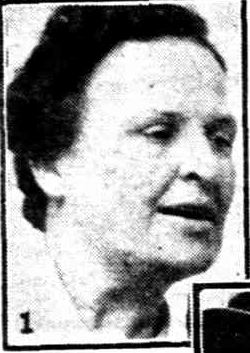
Sentenced to life imprisonment in 1942 she has become a model prisoner. She particularly asked to be allowed to go on ‘war work’. She has been seamstress and maker of military shirts.
2. Herbert Kopit – Bundaberg mail-train killer.
Kopit’s job has been on a button holing machine. He has been commended for the way he turns out military tunics. He seems to genuinely appreciate them.
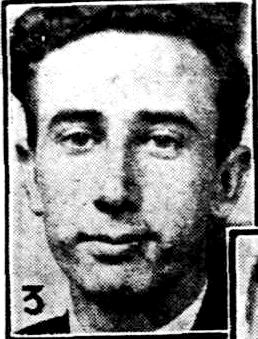
Record keeper for war work done in the prison
4. James Callaghan – Cunnamulla bore-drain murderer
Works in the tinsmith shop principally repairing hurricane lamps, tin mugs and plates.
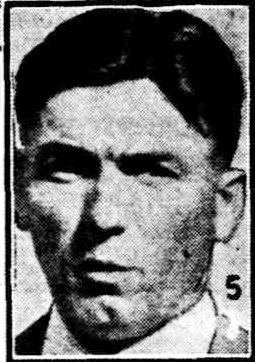
Airs works hard with cutting-out scissors. He likes the job. Airs never misses a news session on the gaol wireless. He follows every act of the war drama with the closest interest.
They’re making shirts, shoes and shovels, mending boots, blankets, trousers and tunics. Every metal sprig they drive into leather, every stitch they insert into a piece of cloth is just another blow delivered for the Allies. They’re a strange mixed lot these Boggo-road lifers. But they’re helping to fight this war for us.
Some would say it is a prisoner’s duty to contribute to the war effort. After all, they were criminals and should work for their keep. Some would say it is good to see that they volunteered to help produce items that would be used in the war. Whichever way you look at it, it was a remarkable achievement. Remember these were not tradesmen. They learned their trade through practice. The sheer number of items produced is astounding.
At the going down of the sun, and in the morning; we will remember them.
Lest We Forget.
Want to know more about these lifers? You can find their stories in the Gaol Shop! Many wonderful publications are available for purchase. These publications are written by Director Jack Sim in conjunction with other local authors. You can order in person or online. So why not visit the Gaol Shop today?
This article was contributed by Research Coordinator Sue Olsen as part of the ongoing research program for Boggo Road Gaol Pty Ltd. The aim of the program is to bring to light and share articles relating to Boggo Road for the purposes of review and study. Do you have a story to share or something you would like us to know about? You can contact the research team here
Officer Stories 3 – Major Arthur Thomas Peirson VD
- On : 19 April, 2018
- By : Boggo Road Gaol
- Category : Stories
- View : 2059
Officer Stories 3 – Major Arthur Thomas Peirson VD
Superintendent for Prisons Brisbane and Chief Controller for Prisons
Peirson served forty-eight years in the prison department, a truly remarkable career. Peirson was a penologist with great humanitarian principles. He was a stern but just disciplinarian in his management of the prisons in Queensland.
Major Arthur Thomas Peirson VD
Superintendent for Prisons Brisbane and Chief Controller for Prisons
Arthur Thomas Peirson was born on the 5th of October 1867 in Newcastle upon Tyne, England to Joseph and Margaret Peirson. A military family, the Peirson’s travelled around Europe before Arthur and his brothers were educated in Scotland.
A military cadet, Peirson served his cadetship under his Uncles tutelage. Upon completion and with the help of his father, Arthur Thomas Peirson obtained a position as clerk for Chief Controller for Prisons A.E. Halloran. Peirson travelled to Queensland in 1885 as a teenager to join the ranks in the prison service.
Military Career
Peirson not content with just completing his cadetship, joined the Queensland Military Forces (QMF) in the 1st Moreton regiment where he served in the Boer War campaign and saw action in the shearers strike in Bundaberg, all while maintaining his position in the prisons department and slowly rising through the ranks.
Peirson remained in the QMF until his retirement at the rank of Major in 1920. He was awarded the Victorian Decoration for long and distinguished service to the QMF.
Prison Career
Peirson was appointed Acting Superintendent for HM Prisons Brisbane in June of 1904 after the death of Superintendent J.V. Williams, a position that Peirson would go on to hold for the remainder of his life.
A prisoner advocate, Peirson achieved great popularity with the officers and prisoners alike. He developed a series of prison reforms that were a very warranted change from the old system of only punishment. Peirson introduced a system of teaching useful trades to the long serving prisoners in the hope that when they were eventually released from prison they will manage to be a functional member of society. In order to achieve this, Peirson himself became proficient at the trades being taught to the prisoners so as best to supervise them. Trades such as brush-making, shirt-making and mat-making were introduced.
Other significant changes were made in the time of Peirson, including the extension of library and educational services for long serving inmates, better food and conditions, more frequent welfare checks and much tighter reigns on the prison staff.
Peirson served forty-eight years in the prison department, a truly remarkable career. Peirson was a penologist with great humanitarian principles; a stern but just disciplinarian in his management of the prisons in Queensland.
Death in Office
Peirson died at his home, at HM Prison Brisbane (later known as Boggo Road Gaol) on the 16th of May 1933 having been suffering from a stubborn illness for some time. He was survived by his devoted wife and only son who also worked in the prison service.
The day Peirson died, an impressive tribute to the memory of their late Chief was paid by the warders of the day shift. As each man finished duty at 5 o’clock, he marched towards the Superintendent’s official residence, halted a few paces from the entrance, stood erect and saluted, before marching, after a moment’s pause, out of the gates. It was a simple, dignified, and spontaneous tribute that bore eloquent testimony to the respect and esteem in which the late Superintendent was held by the prison staff.
The funeral procession was equally as impressive. A guard of honour led by Senior Warder Dwyer was drawn up outside of the Superintendent’s residence. Lt. Governor Sir James Blair and Registrar of the Supreme Court Mr. F. S. Kennedy entered the residence where a small service was held. The cortege then made its way to the South Brisbane Cemetery where Major Peirson was laid to rest. His grave is adorned with a lovely monument.
Sadly, we can’t hear from Major Peirson about his time as Superintendent. You can, however, hear from another officer this Sunday on our officer tour! Be guided through Boggo Road Gaol by former officer Kevin Hayden; hear from him all about some of the most terrifying riots, thrilling escapes and infamous prisoners! Click here to book.
This article was contributed by Research Coordinator Sue Olsen as part of the ongoing research program for Boggo Road Gaol Pty Ltd. The aim of the program is to bring to light and share articles relating to Boggo Road for the purposes of review and study. Do you have a story to share or something you would like us to know about? You can contact the research team here
Prisoner Stories 3 – Charles Kenneth Apjohn Carter
- On : 13 April, 2018
- By : Boggo Road Gaol
- Category : Stories
- View : 1971
Charles Kenneth Apjohn Carter
International fraudster, swindler and thief.
Ever heard the saying ‘a champagne taste on a beer budget’? It is a saying that I have certainly grown up with. Charles Kenneth Apjohn Carter is simply synonymous for making the very, very best of a bad situation. At one time he broke bread with the best of Brisbane, now he is enjoying hominy with the worst of Boggo Road Gaol.
 Charles Kenneth Apjohn Carter
Charles Kenneth Apjohn Carter
Known alias: Charles Kenneth Carter, Charles Kenneth, Charles Kennett and Nick Carter.
Native Place: India
Age: 37 Years
Height: 5 feet 10 ½ inches
Make: Proportionate
Complexion: Fresh
Hair: Brown
Eyes: Hazel
Weight : 11stone 6 oz
Remarks: Appendicitis Scar, Long scar and mole on right temple, shrapnel scar above left kneecap.
Ever heard the saying ‘a champagne taste on a beer budget’? It is a saying that I have certainly grown up with. Charles Kenneth Apjohn Carter is simply synonymous for making the very, very best of a bad situation. He had falsely stated his worth for all to see…. Meanwhile pinching everything he can get his hands on!
Perhaps the most remarkable case of “False Pretences” to have ever graced the halls of Boggo Road Gaol; Charles Kenneth Apjohn Carter had swindled people out of their hard earned money over three states in Australia in the previous months. He had at each turn, escaped justice. His run of luck finally ran out when he was arrested at Murwillumbah and brought back to face five charges of passing a dodgy cheque and theft in the Police Magistrates Court in Brisbane in 1927. Found guilty, Carter was sentenced to two and half years inside Boggo Road Gaol.
He was a most gifted crook, having been born in India to a British family; he had spent most of his young life in England. In turn, he had gained himself the knowledge to pass himself off as a right proper gentleman of the highest order.
The Crime
Passing himself off as an Air Marshall, Major, Captain and golf professional at various points, he had hob knobbed around Brisbane, Warwick, Sunshine Coast and Southport with the finer classes of society. Carter dressed himself in the finest uniform of a Royal Air Force Officer complete with distinguished war medals. Arriving in Brisbane, He had recruited a woman of disrepute to take his arm and pull of this charade as “Major” and Mrs. Carter “honeymooning” in Brisbane promising her wealth. Of course, this was all just part of the swindle! When it came time to face the court, the mysterious Mrs. Carter had been ripped off too! Carter had passed her a dodgy cheque, just like all the others. None of his self-imposed titles were at all true. The plain truth of the matter was, Carter was enlisted as a mechanic in the R.A.F in 1917, had been discharged and had re-enlisted in 1918 before deserting and turning to crime.
Prior Convictions
Charles Kenneth Apjohn Carter is known all over the world for his antics. He had been charged and sentenced for fraud in the London. He was charged and declared insane in Edinburgh and served four years in an Asylum, again for fraud. There were warrants for his arrest in Canada, where he had passed himself off as a decorated pilot, even planning himself an elaborate banquet in Winnipeg, but obviously, the banquet never went ahead as he had yet again disappeared. He then allegedly went to California where had smuggled Chinese migrants into America via Mexico. All of this prior was to his assault on the good people in Australia.
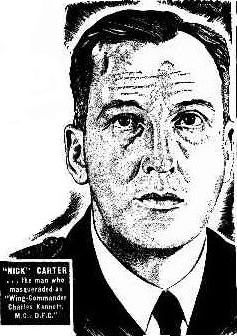
Certainly his story is one of pure fantasy, He had an inflated sense of self… and if everything else wasn’t enough. He published his autobiography in 1936, under yet another alias Charles Kennett. The Stormy Petrel is sadly out of print. However a copy is held at the National Library in Canberra.
Do yourself a favour, check out the remarkable story of Charles Kenneth Apjohn Carter further. It has certainly been one of the most fascinating and at times hilarious stories I have had the privilege to share.
This Sunday, you can hear more stories from a prisoner’s perspective. Larry Campbell, a former prisoner at Boggo Road, will guide you through some of the most turbulent years of the Gaol’s history. To book tickets for our fascinating prisoner tour click here.
This article was contributed by Research Coordinator Sue Olsen as part of the ongoing research program for Boggo Road Gaol Pty Ltd. The aim of the program is to bring to light and share articles relating to Boggo Road for the purposes of review and study. Do you have a story to share or something you would like us to know about? You can contact the research team here.
Escape! Benjamin Metcalfe
- On : 5 April, 2018
- By : Boggo Road Gaol
- Category : Stories
- View : 1920
ESCAPE! Benjamin Metcalfe
Just before 9am on Thursday 21st February 1924, Benjamin Metcalfe was at his usual work in the bookmaker’s shop when he decided it was time to escape from gaol.
ESCAPE! Benjamin Metcalfe
Benjamin Metcalfe
Alias: George Benjamin Mitchell
Crime: Stealing, Break and Enter, Burglary.
Sentence: 7 Years with hard labour
Escaped: Thursday 21st February 1924
From: HM Prison for men Brisbane (later known as No 2 Division Boggo Road Gaol)
Escape!
Just before 9am on Thursday 21st February 1924, Benjamin Metcalfe was at his usual work in the bookmaker’s shop when he decided it was time to escape from gaol. He approached the officer on duty and asked permission to leave his work to attend the sick ward at the hospital. For some reason, this was granted, and he was allowed unescorted to leave the shop. He scaled a fence at the back of the kitchen and gathered his fashioned rope ladder and threw it over the wall. Hooking it on the rail of the tower he quickly scaled the wall and disappeared. Sightings over the coming hours had him heading in the direction of Beaudesert.
No one missed Metcalfe until around 1pm when it became panic stations. Every officer was engaged in looking for him. The escape was reported to the police, but was kept from the public until the following day.
He wasn’t free for long however, as Metcalfe was recaptured just two days later at Logan Village.
The ladder
Thirty feet in length, the rope was made of 24 strands of shoemaker’s cotton twine which was twisted and coated with bees wax. This made a light cord with great strength.
The rungs were of pine, neatly rounded to half inch thickness, about six inches in length. Apparently these were made out of the ends of kerosene cases.
The cord was carefully wound round each several times and further secured by a nail.
For the grappling hook, the handle of a cell bucket had been commandeered and was weighted with a cobblers hammer.
Metcalfe worked in the bookmaker’s shop and had ready access to the requirements of the ladder; however, it still would have taken months to squirrel away the pieces of his incredible creation.
But how did he construct it and keep it hidden from the authorities? That was the subject of a board of enquiry. Five officers were suspended until the enquiry, two found guilty of negligence and carelessness in discharge of their duty.
The tower which was unattended too had been a source of controversy. Ultimately the Home Secretary Shopford accepted the blame for the tower being unattended. Still, he had numerous questions on how an escape of this kind could happen in broad day light. The tower, at the end of the day, was unguarded due to budget cuts.
Bad from Boyhood
Metcalfe was certainly no angel, he had been in trouble from a young age, skipping school and running away from home at twelve. This was just the beginning of a lifelong career afoul of the law. At twelve and a half Metcalfe was sentenced to five years in Westbrook Industrial home for stealing a purse. Eventually he saw his first year in prison in 1908 this time for Burglary.
With the exception of his two years away in the army during World War One (even during that he misbehaved) he didn’t spend much longer than a month or two at a time out of gaol.
Somehow, he managed to meet and find a girl to marry and have two children. When he wasn’t in gaol, it seemed he was with either his family or staying with his mother.
His last known sentence at Boggo Road Gaol was for selling sly grog during World War Two. He was living with his mother at Albion at the time. The sentence was short (for him) just six weeks.
His mother died in 1950, after the funeral, he travelled south to Scone, New South Wales to visit family. Metcalfe died there just a few months later.
Want to see where Metcalfe went over the wall? You can! Join us for our Escapes tour this Sunday!
Hosted by Director Jack Sim, you will hear of some of the greatest escape stories from the history of Boggo Road Gaol. To book click here
This article was contributed by Research Coordinator Sue Olsen as part of the ongoing research program for Boggo Road Gaol Pty Ltd. The aim of the program is to bring to light and share articles relating to Boggo Road for the purposes of review and study. Do you have a story to share or something you would like us to know about? You can contact the research team here


